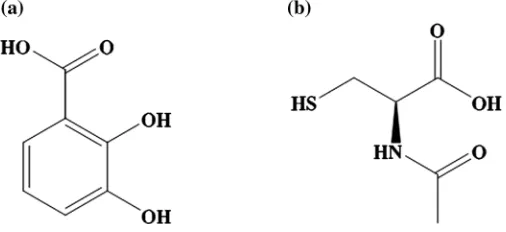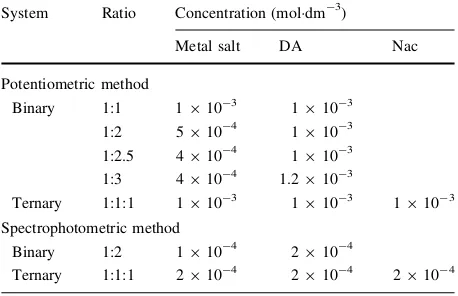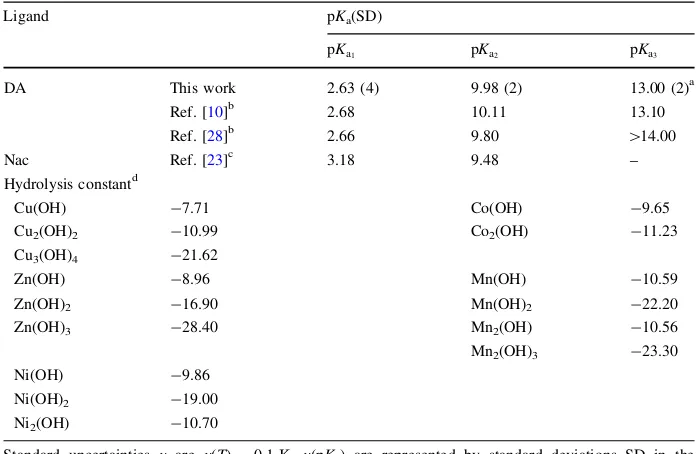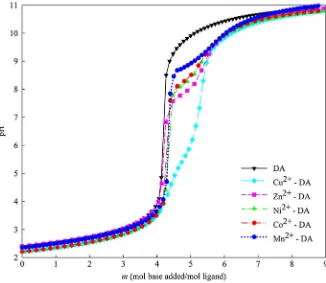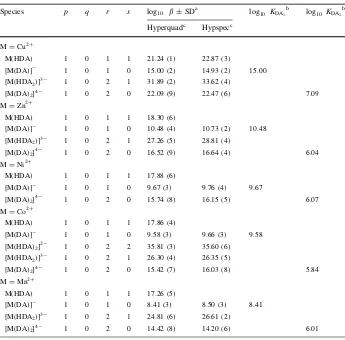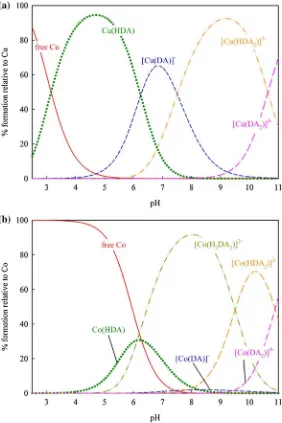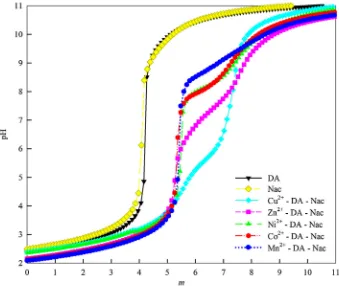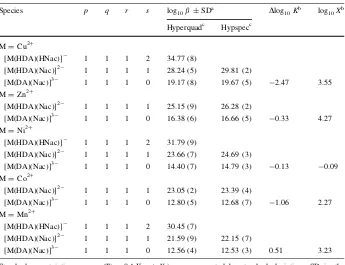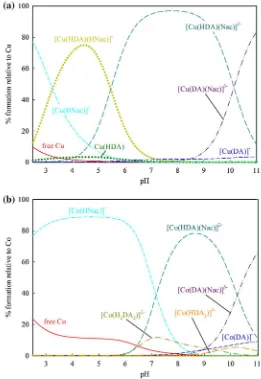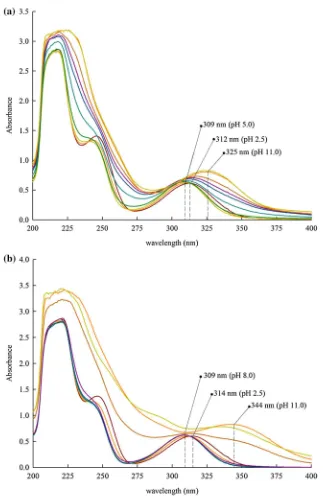Complex Formation Study of Binary and Ternary
Complexes Including 2,3-Dihydroxybenzoic Acid,
N
-acetylcysteine and Divalent Metal Ions
Shella Permatasari Santoso1•Artik Elisa Angkawijaya1,2• Suryadi Ismadji3•Aning Ayucitra3•Felycia Edi Soetaredjo3• Tran Nguyen Phuong Lan4•Yi-Hsu Ju1
Received: 22 October 2015 / Accepted: 18 January 2016 / Published online: 1 March 2016 ÓSpringer Science+Business Media New York 2016
Abstract The binary and ternary complex stability constants between 2,3-dihydroxy-benzoic acid (DA) and N-acetylcysteine (Nac) with the divalent metal ions (M) Mn2?, Co2?, Ni2?, Cu2?and Zn2? were studied in aqueous solution at 310.15 K and an ionic medium of 0.15 moldm-3 NaCl. The complexes’ stability constants (log10 b), refined
from the potentiometric data using the Hyperquad2008 program, indicate that the ternary complexes are more stable than the binary complexes. The stability constants were sup-ported by additional computation, refined from the spectrophotometric data using the Hypspec program. The values of the ternary complex stability relative to their binary complex (Dlog10K) and the disproportionation constant (log10X) indicate that formation
of ternary complex species [M(DA)(Nac)]3-is more favorable than that of species formed by two identical ligands, [M(DA)2]4
-or [M(Nac)2]2
-. For the investigated M, the stability of complexes follows the trend Cu2?[Zn2?[Ni2?[Co2?[Mn2?.
Keywords Stability constantPotentiometryN-acetylcysteine2,3-dihydroxybenzoic acidDivalent metal
1 Introduction
2,3-Dihydroxybenzoic acid (DA) is a powerful iron chelator with a Fe3?-DA complex stability constant (log10K1) value of 20.5 [1]. The chelating ability of DA makes this
compound useful in the excretion of excess iron [2]. DA naturally exists in plants such as
& Yi-Hsu Ju
1
Chemical Engineering Department, National Taiwan University of Science and Technology, Taipei 106-07, Taiwan
2
Institute of Plant and Microbial Biology, Academia Sinica, Taipei 115-29, Taiwan
3 Department of Chemical Engineering, Widya Mandala Surabaya Catholic University, Kalijudan 37,
Surabaya 60114, Indonesia
4
Salvinia molesta, lobi–lobi fruit (Flacourtia inermis) and gooseberries (Phyllanthus acidus) [3,4] and also in blood plasma and urine of human, as the product of aspirin metabolism [5,6]. Biologically, DA provides health benefits due to its antioxidant, anti-inflammatory and antimicrobial actions.
DA may act as a salicylate (COO–, ortho-O–) type ligand or catecholate (ortho-O–,
meta-O–) type ligand [7–10]. Recently, researchers demonstrated that DA also can bind metal ions such as Al3?, VO2?, Mn2?, Cu2? and Cd2?as summarized in IUPAC equi-librium data report [11]. To the best of our knowledge, there are only a few reports on the stability constant of DA with divalent transition metal ions; excesses of these metal ions in human body may lead to metal toxicity. DA is often designated as a di-protic, H2L, ligand
(with 2 protonation constants, for the COO– and meta-O– groups) instead of tri-protic, H3L, ligand [9–11]. Thus, in this work we attempted to treat DA as a tri-protic ligand by
determining the protonation constant of theortho-O– by means of spectrophotometry; this was then used for the stability constant determinations.
Ternary complex study is interesting, because it is expected that the combination of two different ligands will give synergistic effect to strengthen stability of the complex, thus dissociation of the metal complex is less likely [12]. In this study,N-acetylcysteine (Nac), an antioxidant that is known as glutathione precursor, mucolytic agent and neuroprotective agent, was chosen to assist the complex formation of DA [13–17]. Nac is known as a drug for treating angina pectoris, acute respiratory distress syndrome, paracetamol overdoses, ischemia–reperfusion cardiac injury, schizophrenia and bipolar disorder [18–22]. Our previous study on Nac with some divalent metal ions (Cu2?, Zn2?, Ni2?, Co2?and Mn2?) indicates that the chelate complexes have stability constants in the range of 3.67 to 6.57 for log10K1 and 3.69 to 6.06 for log10K2, which is sufficient for the chelate complex to
disassociate [23]. Thus the combination of DA and Nac was expected to give a higher stability for the complexes formed. All the complexes formed were observed in conditions comparable to human blood (i.e. 310.15 K and ionic strength of 0.15 moldm-3 NaCl). The equilibrium constants were refined using the Hyperquad2008 and Hypspec computer programs.
2 Chemicals and Solutions
Chemicals used in this study and their suppliers are as follows: analytical grade metal salts of nickel chloride hexahydrate (NiCl26H2O, 98 %) was supplied by Alfa Aesar
(Lan-cashire, UK); copper chloride dehydrate (CuCl22H2O, 99 %), cobalt nitrate hexahydrate
(Co(NO3)26H2O, 98 %), and zinc nitrate hexahydrate (Zn(NO3)26H2O, 98 %) were
purchased from Sigma Aldrich (St. Louis, USA); and manganese chloride tetrahydrate (MnCl24H2O, 99.8 %) was supplied from Fisher Scientific (New Jersey, USA). The
2,3-dihydroxybenzoic acid (DA, C7H6O4, 99 %) was supplied by Alfa Aesar (Lancashire, UK)
and N-acetylcysteine (Nac, C5H9NO3S, 99 %) was purchased from Sigma Aldrich (St.
Louis, USA); their structures are shown in Fig.1.
Sodium hydroxide (NaOH, 96 %) was provided by Yakuri Pure Chemical (Kyoto, Japan); potassium hydrogen phthalate (KHP, 99.95 %), and ethylenediaminetetraacetic acid (EDTA, C10H16N2O8, 98.5 %) were purchased from Sigma Aldrich (St. Louis, USA);
sodium chloride (NaCl, 99.5 %) was obtained from Showa (Tokyo, Japan). Metal salt solutions were standardized by complexometry against EDTA. Carbonate free NaOH (0.1 moldm-3) used as titrant was standardized against KHP. HCl (0.03 moldm-3) was prepared and used after standardization. All solutions were prepared freshly before use, using ultra pure water obtained from an ultrapure water system with a resistance of 18.3 MXcm-1.
3 Experimental and Computational
3.1 Potentiometric Method
Potentiometric titrations were performed in a 150 cm3 commercial double walled glass vessel under N2atmosphere. Reaction temperature was maintained at 310.15±0.2 K and
the ionic strength of 0.15 moldm-3 NaCl (pKw= -13.384). A Metrohm 888 Titrando
potentiometer, with an 805 Dosimat, Ecotrode Plus pH glass electrode and 802 rod stirrer with 804 Ti stand, was used for the measurements. The electrode used for the measure-ments has a precision of±0.001 pH unit. The potentiometer, equipped with the titration software Tiamo2.3 and coupled to a personal computer, was used to control the titration and record the data. Calibration of the electrode was by means of strong acid–strong base titration, towards solution (a) defined right below, using the GLEE program [24].
For the equilibrium constant determination of binary and ternary systems, the following solutions each with a total volume of 50 cm3 were prepared and titrated against equal increments of added 0.1 moldm-3carbonate-free NaOH:
Table 1 Experimental condition
(a) 0.003 moldm-3HCl?0.15 moldm-3NaCl (b) Solution (a)?0.001 moldm-3ligand DA (c) Solution (a)?ligand DA?metal salt
(d) Solution (a)?ligand DA?ligand Nac?metal salt
The equilibrium constants include: the acid dissociation constant of ligand DA, which was determined by titrating solution (b); the metal complex stability constant, which was determined by titrating solution (c) at four different metal to DA molar ratios of 1:1, 1:2, 1:2.5 and 1:3; while ternary metal complex solution (d) was determined at a metal to DA to Nac molar ratio of 1:1:1. The total concentration of each compound used in the experiment is shown in Table1. Each solution was thermostatted at 310.15 K and left to stand for 15 min before titration. The titration was carried out up to pH=11.0. Each titration was repeated at least three times under controlled conditions, with a reproducibility of±0.04 pH unit.
Computations of complex equilibrium constants were performed by processing the potentiometric data using Hyperquad2008 program [25]. The objective function was given asU=R (Wir2i), whereWiis the weight at theith data point andriis the square of the
difference between the observed and the calculated pH values. The Gauss–Newton– Marquardt method was adopted to minimize the objective function.
All constants are presented as overall formation constant in logarithm value (log10bpqrs)
and expressed by the following equation:
pM þqNac þrDA þsHMpNacqDArHs
The selected model was the one that gave the best statistical fit, was chemically sensible and consistent with the titration data. The species distribution of each metal complex at the observed pH was produced by the HySS2009 simulation program, based on the refined stability constants [26].
3.2 Spectrophotometric Method
Spectrophotometric measurements were conducted using a JASCO V-550 spectropho-tometer in a standard 1 cm path length quartz cell. The measurement was done by scanning the spectra of the solutions of binary and ternary systems (Table1) from 200 to 400 nm. The spectra of each solution were measured at pHs between 2.5 and 11.0, where the pH was adjusted by using 0.1 moldm-3NaOH. The spectral data at various pHs were used to refine the formation constants using the Hypspec program [25,27]. Spectral analyses were also carried our for the solution containing DA:Nac:metal (1:1:1) with a molar concen-tration of 2910-4mol
dm-3prior to the confirmation of the ternary species formation.
4 Results and Discussion
4.1 Ligand Acid–Base Behavior
that a more basic pH is needed to release a hydrogen ion. As a tri-protic ligand, DA possesses three functional groups, namely a carboxylic (COO–) group and two hydroxyl (O–) groups at ortho (ortho-O–) and meta (meta-O–) positions. As obtained from the potentiometry data, the deprotonation of COO– group has a pKa1value of 2.63 and the second
deprotonation occurs at themeta-O– group with a pKa2value of 9.98. The second
deproto-nation is more likely to occur atmeta-O– since this site is more reactive than theortho-O–. This behavior is influenced by the electronic effect of the substituent groups and also the COO– functional group which makes theortho-O– less nucleophilic thanmeta-O–. Since the
ortho-O– is less nucleophilic, a higher basic condition was needed for its deprotonation (third deprotonation). Thus, spectrophotometry was used to determine the deprotonation of the
ortho-O– group instead of potentiometry; the pKa3obtained forortho-O– 13.00.
These pKavalues and the deprotonation order of DA are in accord with the studies of
Turkel et al. [10] and Kiss et al. [28]. In the case of Nac, the first deprotonation occurs at its COO– group with a pKa1 value of 3.18, followed by the thiol S– group with a pKa2
value of 9.48 [23]. The pKavalues of the ligands are given in Table2 and used for the
calculation of the metal complex formation. Besides the pKas of the ligands, the
hydrolysis constants of the metal ions shown in Table2 were also introduced into the calculation.
Table 2 Dissociation constant of DA and Nac at 310.15 K andI=0.15 moldm-3
NaCl
Standard uncertainties u are u(T)=0.1 K, u(pKa) are represented by standard deviations SD in the
parentheses for last place of decimal
a Spectrophotometry,
I=0.15 moldm-3NaCl,
T=310.15 K
b
Potentiometry,I=0.20 moldm-3
KCl,T=298.15 K
c
Potentiometry,I=0.15 moldm-3
NaCl,T=310.15 K
d
4.2 Complexation Study of Binary Systems
The divalent metal ions Cu2?, Zn2?, Ni2?, Co2?and Mn2?were studied with DA and Nac. In our previous study on Nac–M chelate complexes, there were three species ([M(Nac)], [M(HNac)]? and [M(Nac)2]2
-formed in the investigated pH range (2.5–11.0). The monoprotonated [M(HNac)]? species, which is formed by the attachment of M2?to the deprotonated COO– group, was observed in the Cu2?, Ni2?, Co2?and Mn2?systems. In this case, the proton is contributed by the H atom of the S– group. The formation of [M(Nac)] species occurs by the attachment of M2?to two deprotonated groups COO– and S–. The other species was [M(Nac)2]2
-which is formed by the attachment of fully deprotonated Nac to the [M(Nac)] species [23].
In DA binary systems, the refinement results from Hyperquad showed that M(HDA), [M(DA)]-, [M(HDA)2]2
-, [M(HDA2)]3
-and [M(DA)2]4
-were the species that gave the best fit to the potentiometric data. As observed in the potentiometry titration curve in Fig.2, the occurrence of inflection points along with pH jumps in M2?–DA systems indicate the formation of metal complex species. In the case of the systems which contain ligand only, the inflection point in the titration curve indicates the deprotonation of an H atom of the ligand’s donor group. An inflection point occurs when sufficient base is added to deprotonate a group (higher value ofmindicates more base was added). In the case of
DA, the inflection points occur atm=4.0 and 5.0 indicating the deprotonation of COO– andmeta-O– groups, respectively.
In the case of M2?–DA, at them*5.0 range the M(HDA) species was formed. The
inflection points concomitantly with pH jump suggest that two functional groups are involved in the formed species, namely the COO– andortho-O– groups (salicylate type coordination), while themeta-O– group was still protonated. The deprotonation ofortho -O– group was promoted by the presence of metal ions that were firstly bond to the CO-O– group. A significant pH jump, observed from the inflection point atm=6.0, suggests a stronger coordination of the metal complex compared to the salicylate type, specifically catecholate (ortho-O–,meta-O–) type, where the corresponding species in this point is [M(DA)]-. In the studies of Kiss et al. on Cu2?–DA complexes [28], Turkel et al. on Al3?-DA complexes [10], and Sahoo et al. on La3?-DA complexes [30], they also proposed that salicylate type complex species of DA tend to form at lower pH and cate-cholate type at higher pH. suggests the involvement of protonated functional groups in the species. In this case, the most thermodynamically sensible forms are: two salicylate (COO–,ortho-O–) coordination in the formation of [M(HDA)2]2
-, and the combination of salicylate (COO–-, ortho-O–) and catecholate (ortho-O–,meta-O–) coordination in the formation of [M(HDA2)]3
-, while the [M(DA)2]4
-species, which are formed at higher pH, suggest the coordination of two catecholates. These proposed forms with specifically mixed combination of salicylate– catecholate type and two catecholate type (at higher pH) are also in good agreement with the literature [10, 28, 30]. In addition, as observed in the titration curve, Cu2?-DA exhibits the strongest pH jump indicating that Cu2?
possesses the strongest coordination with DA.
The overall stability constants (log10 b) of M2
?
-DA complexes are given in Table3.
There is good agreement between log10 b values from potentiometry and
spectropho-tometry. As summarized in Table3, the stability of the complexes shows a decrease in the order of Cu2?
[Zn2?[Ni2?[Co2?[Mn2? which is in accordance with the Irving–
Williams order [31]. This Irving–Williams order is linear with the decrement of metal ions
atomic number, where Zn2? (30 pm)[Cu2? (29 pm)[Ni2? (28 pm)[Co2?
(27 pm)[Mn2?(25 pm). The increase of the metal ion’s electronegativity is proportional
to the increase of its atomic number. In the case of Cu2?, the atomic number of Cu2?is smaller than Zn2?but it has a more stable complex. This phenomenon is due to the smaller electronegativity of Zn (Zn (1.65)\Cu (1.99)). The high log10 bof Cu2?is also due to
Jahn–Teller distortion of an octahedral complex, which results in stabilization of the complex [32,33].
The species distribution diagrams of these species were calculated from the log10b
values and graphically presented by HySS as given in Fig.3, representatively, by Cu2?and Co2?
. As shown in Fig.3a for Cu2?
and3b for Co2?
, the [M(DA)]
-is formed at higher pH than that of M(HDA), suggesting that further deprotonation is necessary to form [M(DA)]-, indicating the coordination of two hydroxyl group to form this species. The formation of [M(HDA)2]2
species also support the assumption that the [M(DA)2]4
-species, which form at higher pH, are coordinated with the O– group and the other species are formed from the combination of salicylate–catecholate binding types.
In addition to metal complexes with fully deprotonated ligand [M(DA)]- and
[M(DA)2]4
log10K2=log10bMDA2-log10bMDA. It can be seen that log10K2\log10K1 due to
repulsion between similar ligands in one complex, which causes a decrease in stability; this is also, due to there being fewer coordination sites on the metal ion, since it has already been occupied by the first coming ligand to form the [M(DA)]- complex [34]. This suggests that the attachment of the second ligand is weaker than that of the first ligand and the formation of [M(DA)2]4
-species is more difficult.
Table 3 Stability constants of M2?
–DA at 310.15 K andI=0.15 moldm-3
Standard uncertainties u are u(T)=0.1 K, u(pKa) are represented by standard deviations SD in the
parentheses for the last place of the decimal
a p,q,randsrepresent the number of metal ion, Nac, DA, and hydrogen ion, respectively
b log
10Kvalue based on Hyperquad refinement
c Stability constants were refined by ‘‘Hyperquad’’ and ‘‘Hypspec’’ using potentiometric and
4.3 Complexation Study of Ternary Systems
Formation of the ternary species [M(HDA)(HNac)]-, [M(HDA)(Nac)]2- and
[M(DA)(Nac)]3- is justified from the analysis of potentiometry data. In Fig.4, the observed ternary titration curve exhibits greater pH jump than that of the corresponding binary system. Atm=5.0–6.0, a pH jump is observed suggesting a stronger coordination compared to that of the salicylate type (COO–,ortho-O–) coordination in binary system. Thus it can be considered that Nac coordinates through the contribution of its COO– group.
A significant pH jump atm=7.0 suggests deprotonation, which is more likely to occur on the S– group of Nac, participated in complex formation. Further deprotonation was
observed from a big pH jump at m=8.0, which occurs on themeta-O– group of DA,
suggesting the catecholate type (ortho-O–,meta-O–) coordination from DA and COO–, S– coordination from Nac.
Stability constants (log10 b) of ternary complexes are recorded in Table4. The results
from potentiometry and spectrophotometry measurements show good agreement. The species distribution of those ternary complex species are graphically represented by Cu2? and Co2?
complexes. As shown in Fig.5a, the first ternary species [Cu(HDA)(HNac)]
-was formed in the pH region where [Cu(HNac)]? was observed. As the [Cu(HNac)]?
concentration decreases the formation of [Cu(HDA)(HNac)]- increases, suggesting that one of the two protons in the ternary species was contributed by the protonated S– group of Nac. Thus, the other proton was contributed by DA through itsmeta-O– group. Next, for [M(HDA)(Nac)]2
-species, since the S– group of Nac is more likely to deprotonate earlier than themeta-O– group of DA, this suggests that the proton in the complex is contributed by the meta-O– group of DA. The final species [M(DA)(Nac)]3- was formed at highly basic pH suggesting deprotonation on themeta-O– group and the species was formed from the binding through catecholate type coordination of ligand DA along with (COO–, S–) coordination of Nac.
Fig. 4 Titration curve on M2?
The parametersDlog10Kand log10Xwere noted as useful to indicate the behavior of
ternary complexes compared to binary complexes [35–39].Dlog10Kexpresses the stability
of the ternary species [M(DA)(Nac)]3- relative to the stability of the binary species, [M(DA)]-and M(Nac); the value is calculated from equation:
Dlog10 K¼log10 bMAB ðlog10bMAþlog10bMBÞ ð2Þ
The parameter log10X expresses the disproportionation tendency of binary species
[M(Nac2)]2
-and [M(DA2)]4
-to form the ternary species [M(DA)(Nac)]3-, where log10X
is calculated from equation:
log10X¼2 log10bMAB ðlog10bMA2þlog10 bMB2Þ ð3Þ
It was found that the complex with the highest log10bvalue for its binary complex tends to
have the most negativeDlog10K value, suggesting that more energy is needed to form a
stable ternary complex from a stable binary complex. However, after the ternary complex is formed, it possesses a greater stability than the binary complex suggesting that the ternary complex is unlikely to disassociate back to the binary. This is supported by the
Table 4 Stability constant of ternary systems at 310.15 K andI=0.15 moldm-3NaCl
Species p q r s log10b±SDa Dlog10Kb log10Xb
Standard uncertainties u are u(T)=0.1 K, u(pKa) are represented by standard deviations SD in the
parentheses for the last place of the decimal
a
p,q,randsrepresent the number of metal ion, Nac, DA, and hydrogen ion, respectively
b
log10Kvalue based on Hyperquad refinement c
log10Xparameter of the ternary species, which generally have positive values, indicating
that the formation of the ternary complex [M(DA)(Nac)]3-is more favorable than that of the binary species [M(DA)2]4
-or [M(Nac)2]2
-[40]. For instance, the [Cu(DA)(Nac)]3
-species has the most negative Dlog10K value (-2.47) since Cu2
?
possesses the most stable binary species log10 b, indicating that less energy is gained in the formation of
ternary species. However it has a positive log10Xvalue of 3.55 indicating greater stability
of its ternary species. In the case of [Mn(DA)(Nac)]3-, theDlog10Kvalue of 0.51
indi-cates that less energy is needed to form ternary species (compared to the Cu2?system) and a log10Xof 3.23 indicates that the ternary complex of Mn is more stable than its binary
species.
Fig. 6 Spectrum measurements of ternaryaCu2?
andbCo2?
system at M2?
4.4 Spectrophotometric Measurements
The addition of metal ion into the ligand system yields a metal–ligand complex, which causes an alteration in the spectral behavior [37,40]. In this work, the spectral measure-ments were done on ternary systems as a function of pH; as shown in Fig.6the wavelength range was 200–400 nm. The aromatic ring of DA gave strong absorbance at 220–250 nm for all systems. The bands observed at longer wavelength are related to the metal–ligand complex. The observed bands show similar shifts in all systems, so the Cu2? and Co2? systems were chosen as representative.
For the Cu2?ternary system, as observed in Fig.5a, at pH=2.5 a band occurred at 312 nm which then exhibited a blue shift to 309 nm as the pH increased to 5.0, which was affected by the formation of [Cu(HDA)(Nac)]2
-species. However with the pH increased to 11.0, the spectrum exhibited another red shift to 325 nm, which is more likely due to the formation of [Cu(DA)(Nac)]3-species. Similarly, for Co2?ternary system in Fig.5b, at pH=2.5 a band was firstly observed at 314 nm, which then exhibited a blue shift to 309 nm as the pH increased to 8.0 but, with increase of pH to 11.0, there was a red shift to
344 nm which was caused by the [Co(DA)(Nac)]3
-species.
and ternary species of DA–Nac ([M(HDA)(HNac)]-, [M(HDA)(Nac)]2-,
[M(DA)(Nac)]3-) were found in the potentiometry analysis, supported by spectropho-tometry analysis. It was found that the binding of M2? to the COO– group of DA was initiated the deprotonation of the meta-O– group, and then formed salicylate type coor-dination. However, at higher pH the coordination changed to catecholate type with respect
to the deprotonation of the ortho-O– group. While for Nac, the COO– group was also
found to attach firstly to metal ions followed by the S– group as pH was increased. The stability constants of the complexes in binary and ternary system showed the same order with that of log10bvalues: i.e. Cu2
?
[Zn2?[Ni2?[Co2?[Mn2?. The analysis of
Dlog10Kand log10Xindicated that formation of ternary species is favorable.
Acknowledgments This work was supported by the Ministry of Science and Technology of Taiwan (NSC 102-2221-E-011-079) and National Taiwan University of Science and Technology (103M47006).
References
1. Avdeef, A., Sofen, S.R., Bregante, T.L., Raymond, K.N.: Coordination isomers of microbial iron transport compounds. 9. Stability constants for catechol models of enterobactin. J. Am. Chem. Soc.100, 5362–5370 (1978)
2. Graziano, J.H., Grady, R.W., Cerami, A.: The identification of 2,3-dihydroxybenzoic acid as a poten-tially useful iron-chelating drug. J. Pharmacol. Exp. Ther.190, 570–575 (1974)
3. George, S., Benny, P.J., Kuriakose, S., George, C., Gopalakrishnan, S.: Antiprotozoal activity of 2,3-dihydroxybenzoic acid isolated from the fruit extracts ofFlacourtia inermisRobx. Asian J. Pharm. Clin. Res.3, 237–241 (2011)
5. Grootveld, M., Halliwell, B.: 2,3-Dihydroxybenzoic acid is a product of human aspirin metabolism. Biochem. Pharmacol.37, 271–280 (1988)
6. Paterson, J.R., Blacklock, C., Campbell, G., Wiles, D., Lawrence, J.R.: The identification of salicylates as normal constituents of serum: a link between diet and health? J. Clin. Pathol.51, 502–505 (1998) 7. Bellaire, B.H., Elzer, P.H., Baldwin, C.L., Roop, R.M.: Production of the siderophore
2,3-dihydroxy-benzoic acid is required for wild-type growth of Brucella abortus in the presence of erythritol under low-iron conditions in vitro. Infect. Immun.71, 2927–2832 (2003)
8. Cam, T., Irez, G., Aydin, R.: Determination of stability constants of mixed ligand complexes of the lanthanum(III) ion and identification of structures. J. Chem. Eng. Data56, 1813–1820 (2011) 9. Hirpaye, B.Y., Rao, G.N.: Chemical speciation of 2,3-dihydroxybenzoic acid complexes with some
biologically essential metal ions in 1,2-propanediol–water mixtures. Chem. Spec. Biolavailab. 25, 179–186 (2013)
10. Turkel, N., Berker, M., Ozer, U.: Potentiometric and spectroscopic studies on aluminium(III) complexes of some catechol derivatives. Chem. Pharm. Bull.52, 929–934 (2004)
11. Lajunen, L.H.J., Portanova, R., Piispanen, J., Tolazzi, M.: Stability constants foralpha -hydroxycar-boxylic acid complexes with protons and metal ions and the accompanying enthalpy changes. Part I: Aromaticortho-hydroxycarboxylic acids. Pure Appl. Chem.69, 329–381 (1997)
12. Lotfi, S., Mazloum-Ardakani, M., Ghasemi, J.B.: Potentiometric study of protonation and complex formation of some amino acids with Zn(II), Co(II) and Ni(II) in aqueous solution. J. Iran. Chem. Res.2, 247–255 (2009)
13. Brosnan, J.T., Brosnan, M.E.: The sulfur-containing amino acids: an overview. J. Nutr.136, 1636–1640 (2006)
14. Geier, D.A., Geier, M.R.: A clinical and laboratory evaluation of methionine cycle-transsulfuration and androgen pathway markers in children with autistic disorders. Horm. Res.66, 182–188 (2006) 15. Jozefczak, M., Remans, T., Vangronsveld, J., Cuypers, A.: Glutathione is a key player in metal-induced
oxidative stress defenses. Int. J. Mol. Sci.13, 3145–3175 (2013)
16. Ozcelik, D., Uzun, H., Naziroglu, M.:N-Acetylcysteine attenuates copper overload-induced oxidative injury in brain of rat. Biol. Trace Elem. Res.147, 292–298 (2012)
17. Parcell, S.: Sulfur in human nutrition and applications in medicine. Altern. Med. Rev.7, 22–44 (2002) 18. Atkuri, K.R., Mantovani, J.J., Herzenberg, L.A.:N-Acetylcysteine—a safe antidote for
cysteine/glu-tathione deficiency. Curr. Opin. Pharmacol.7, 355–359 (2007)
19. Chen, W., Ercal, N., Huynh, T., Volkov, A., Chusuei, C.C.: CharacterizingN-acetylcysteine (NAC) and N-acetylcysteine amide (NACA) binding for lead poisoning treatment. J. Colloid Interface Sci.171, 144–149 (2012)
20. Dilger, R.N., Baker, D.H.: OralN-acetyl-L-cysteine is a safe and effective precursor of cysteine. J. Anim. Sci.85, 1712–1718 (2007)
21. Samuni, Y., Goldstein, S., Dean, O.M., Berk, M.: The chemistry and biological activities of N -acetylcysteine. Biochim. Biophys. Acta1830, 4117–4129 (2013)
22. Zafarullah, M., Li, W.Q., Sylvester, J., Ahmad, M.: Molecular mechanisms ofN-acetylcysteine action. Cell. Mol. Life Sci.60, 6–20 (2003)
23. Santoso, S.P., Chandra, I.K., Soetaredjo, F.E., Angkawijaya, A.E., Ju, Y.-H.: Equilibrium studies of complexes betweenN-acetylcysteine and divalent metal ions in aqueous solutions. J. Chem. Eng. Data
59, 1661–1666 (2014)
24. Gans, P., O’Sullivan, B.: GLEE, a new computer program for glass electrode calibration. Talanta51, 33–37 (2000)
25. Gans, P., Sabatini, A., Vacca, A.: Investigation of equilibria in solution. Determination of equilibrium constants with the HYPERQUAD suite of programs. Talanta43, 1739–1753 (1996)
26. Alderighi, L., Gans, P., Ienco, A., Peters, D., Sabatini, A., Vacca, A.: Hyperquad simulation and speciation (HySS): a utility program for the investigation of equilibria involving soluble and partially soluble species. Coord. Chem. Rev.184, 311–318 (1999)
27. Gans, P., Sabatini, A., Vacca, A.: Determination of equilibrium constants from spectrophometric data obtained from solutions of known pH: the program pHab. Ann. Chim.89, 45–49 (1999)
28. Kiss, T., Kozlowski, H., Micera, G., Erre, L.S.: Copper(II) complexes of 2,3-dihydroxybenzoic acid. J. Coord. Chem.20, 49–56 (1989)
29. Pettit, L.D., Powell, K.J.: A comprehensive database of published data on equilibrium constants of metal complexes and ligands. IUPAC and Academic Software (2001)
30. Sahoo, S.K., Bera, R.K., Baral, M., Kanungo, B.K.: Spectroscopic and potentiometric study of 2,3-dihydroxybenzoic acid and its complexation with La(III) ion. Acta Chim. Slov.55, 243–247 (2008) 31. Irving, H., Williams, R.J.P.: The stability of transition-metal complexes. J. Chem. Soc. 3192–3210
32. Frank, P., Benfatto, M., Szilagyi, R.K., D’Angelo, P., Longa, S.D., Hodgson, K.O.: The solution structure of [Cu(aq)]2?and its implications for rack-induced bonding in blue copper protein active sites. Inorg. Chem.44, 1922–1933 (2005)
33. Aljahdali, M., El-Sherif, A.A., Shoukry, M.M., Mohamed, S.E.: Potentiometric and thermodynamic studies of binary and ternary transition metal(II) complexes of imidazole-4-acetic acid and some bio-relevant ligands. J. Solution Chem.42, 1028–1050 (2013)
34. Graddon, D.P.: An Introduction to Co-ordination Chemistry, vol. 3. Pergamon Press, Canada (1968) 35. Ammar, R.A., Al-Mutiri, E.M., Abdalla, M.A.: The determination of the stability constants of mixed
ligand complexes of adenine and amino acids with Ni(II) by potentiometric titration method. J. Fluid.
301, 51–55 (2011)
36. Angkawijaya, A.E., Fazary, A.E., Ismadji, S., Ju, Y.-H.: Cu(II), Co(II), and Ni(II)–antioxidative phe-nolate–glycine peptide systems: an insight into its equilibrium solution study. J. Chem. Eng. Data57, 3443–3451 (2012)
37. Hernowo, E., Angkawijaya, A.E., Fazary, A.E., Ismadji, S., Ju, Y.H.: Complex stability and molecular structure studies of divalent metal ion with L-norleucine and vitamin B3. J. Chem. Eng. Data56, 4549–4555 (2011)
38. Shobana, S., Dharmaraja, J., Selvaraj, S.: Mixed ligand complexation of some transition metal ions in solution and solid state: spectral characterization, antimicrobial, antioxidant, DNA cleavage activities and molecular modeling. Spectrochim. Acta Mol. Biomol. Spectros.107, 117–132 (2013)
39. Sigel, A., Sigel, H., Sigel, R.K.O.: Metal Ions in Biological Systems, Biogeochemical Cycles of Ele-ments, vol. 43. Taylor and Francis, New York (2005)
